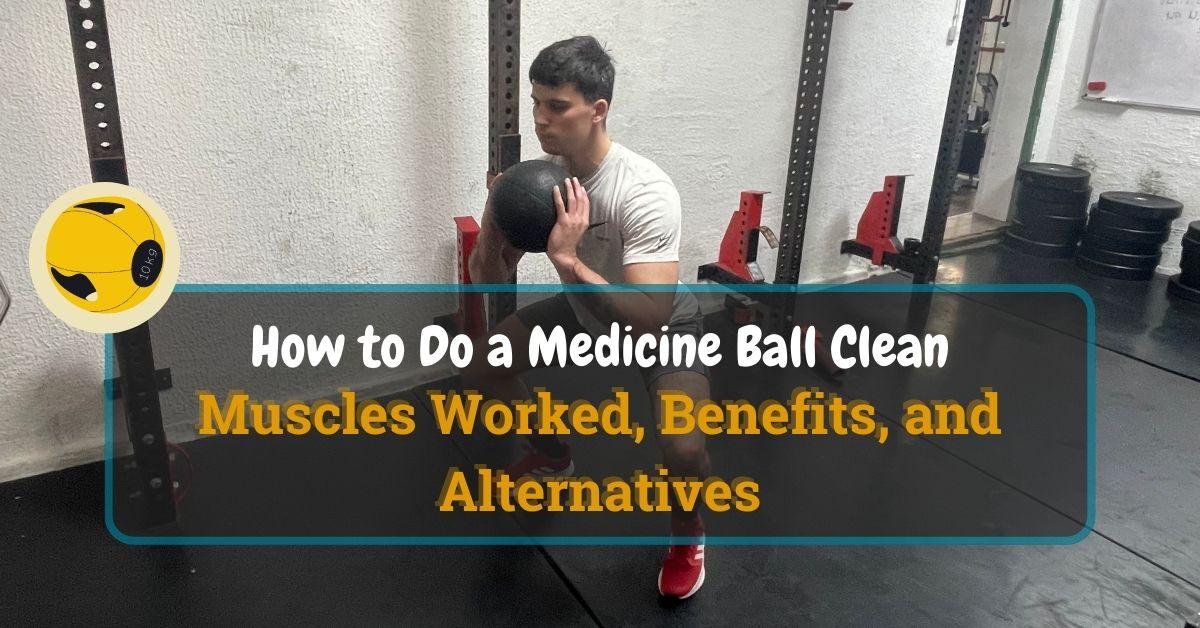Medicine ball clean is one of the few foundational CrossFit exercises. While it sounds like an exercise for the elderly, that’s just not the case. Medicine balls have been used for training for about the last three thousand years, way before bars and machines were invented. And that is for a reason. It will challenge you differently than machine exercises.
Table of Contents
ToggleIt is a cardio-based exercise, in some sense, that also builds muscle. It will give you a full body workout, strengthen your legs, core, and shoulders, and improve your endurance and explosive strength.
Start Building Your Dream Body Today
Ready to elevate your fitness game without falling into the trap of dull, repetitive routines that just don’t deliver? Imagine sculpting your ideal physique and boosting your health, all while still enjoying life’s pleasures, like those irresistible weekend getaways and your aunt’s legendary cheesecake. With our online fitness and nutrition coaching service, you don’t have to compromise. Dive into a personalized fitness journey that blends perfectly with your lifestyle, not against it. Book your completely free discovery consultation today, and take the first step towards a transformation that doesn’t require giving up the joys of life.

“I was skeptical about online fitness coaching, but Functional Body Savage completely changed my perspective. Vanja and Radomir’s personalized approach and attention to detail have helped me achieve goals I never thought possible. I’m stronger, more confident, and grateful for their guidance.”
Emily Thompson, San Francisco, CA
Learn More About Our Online Coaching ServiceQuick Summary
- Medicine ball clean is a foundational CrossFit exercise that targets the legs, core, and shoulders.
- Depending on the load and programming you choose, the benefits may include cardiovascular health, endurance, and explosive strength.
- Medicine ball cleans are functional exercises because they represent everyday movements, such as picking up objects and putting them on high shelves.
- Some of the variations and alternative exercises, like medicine ball clean to press and kettlebell swings, might be more viable for you than medicine ball clean.
How to Do a Medicine Ball Clean
Here’s how to do medicine ball cleans in three simple steps.
Step One — Assume the Starting Position
Start by having a medicine ball between your feet. Place feet shoulder-width apart, knees in line with toes. With straight arms, place the palms on the outside of the ball, fingers pointing down.
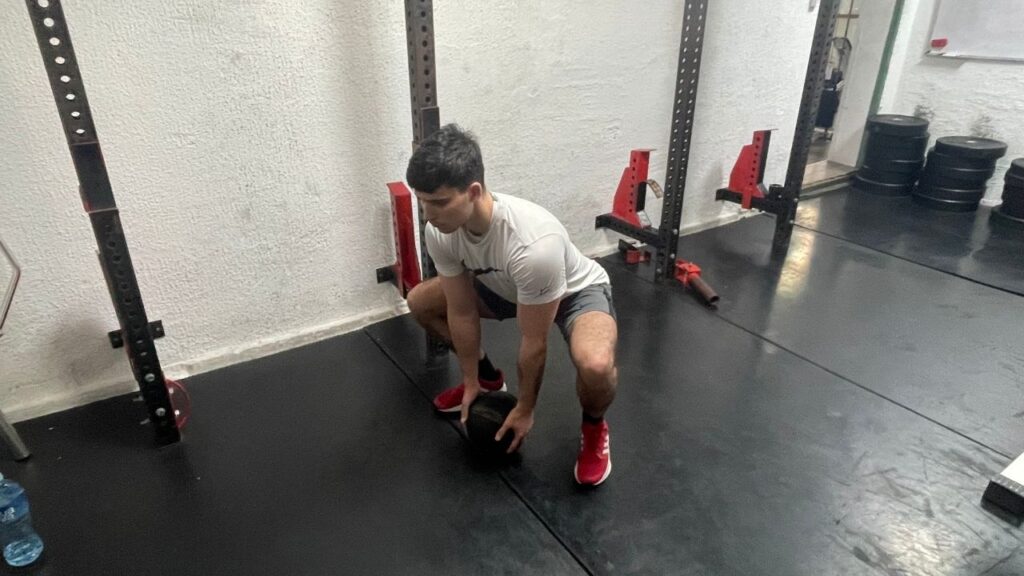
Pro tip: Maintain a firm grip on the medicine ball throughout the movement to control it effectively.
Step Two — Clean the Ball to the Front Rack Position
Start the movement by explosively extending your hips, knees, and ankles while simultaneously pulling the medicine ball upward. As the ball rises, shrug your shoulders and pull your elbows high, allowing the ball to flip onto the front of your shoulders. Catch the ball in a squat position with your elbows high and chest up.
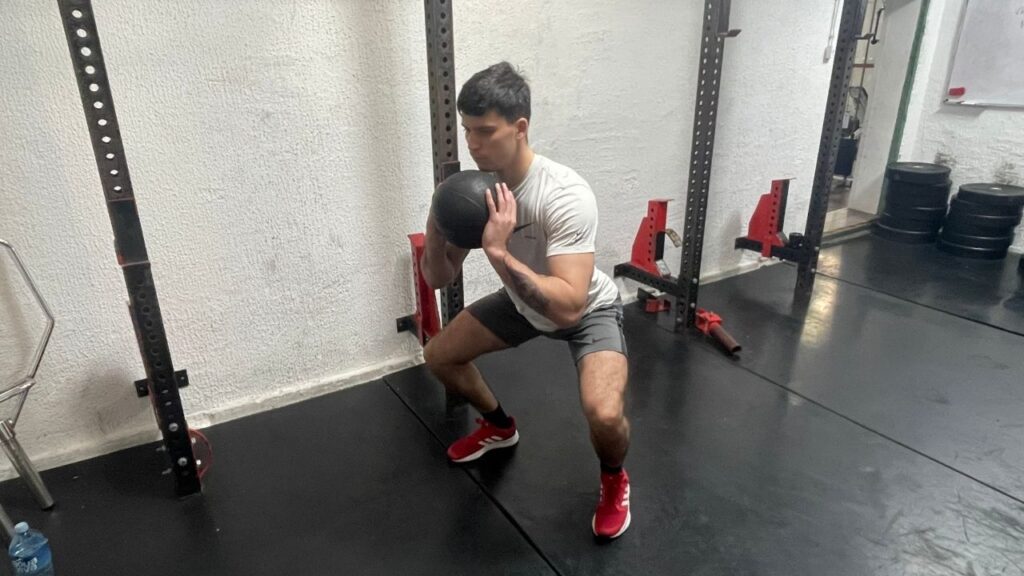
Pro tip: To lift the ball efficiently, focus on generating power from your lower body and smoothly transferring it to your upper body.
Step Three — Return the Med Ball to the Starting Position
Once you’ve caught the ball in the squat position, stand up by extending your hips and knees while keeping the ball close to your body. Finish in a standing position with the ball at shoulder height, elbows pointing forward. Drop the ball on the floor and repeat the whole process again.
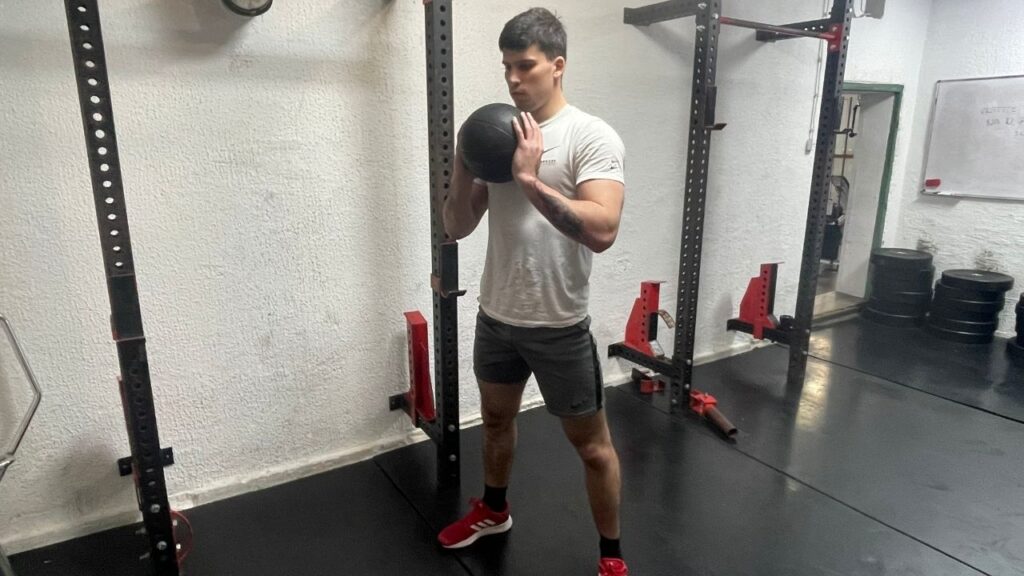
Pro tip: Keep your chest up and back straight throughout the movement to maintain proper posture and prevent injury.
Med Ball Clean Muscles Worked
The medicine ball clean primarily targets the legs, core, and shoulders while engaging secondary muscles such as the forearms, upper back, and calves for stabilization and support.
Here’s a more detailed list of primary targeted muscles:
- Legs: quadriceps, hamstrings, and glutes
- Core: abdominals and lower back
- Shoulders: the deltoids(particularly the anterior (front) deltoid)
Medicine Ball Clean Benefits
Down below are the benefits of medicine ball clean that stand out.
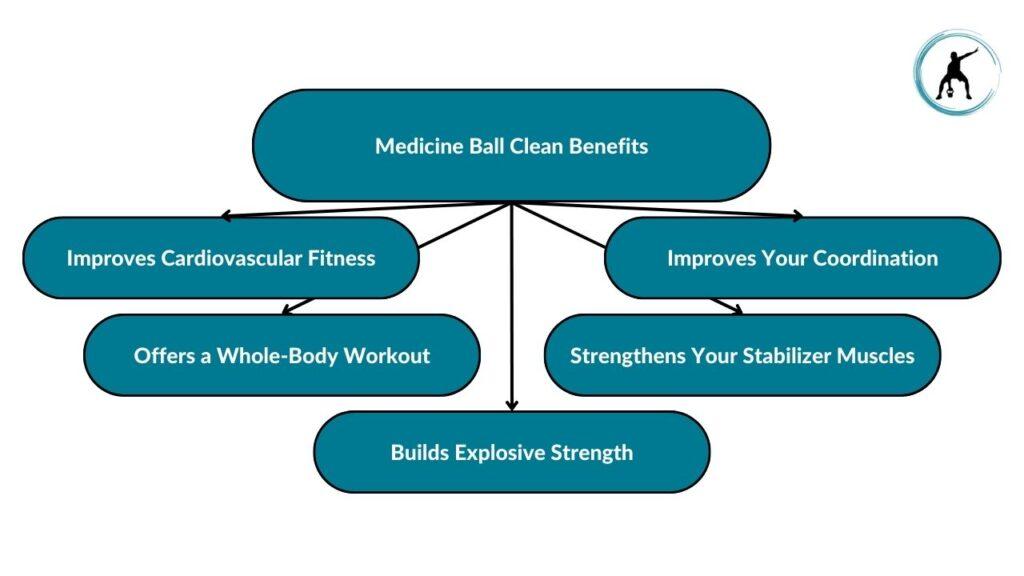
Improves Cardiovascular Fitness
Because of the medicine ball clean’s dynamic and explosive nature, which raises your heart rate, it will train your cardiovascular endurance. Sustained movement and engagement of a large amount of muscle also help train your cardiovascular endurance and health.
However, this will all primarily depend on the loading, tempo, and programming you choose to follow for med ball cleans.
Offers a Whole-Body Workout
Medicine ball clean works for all muscle groups, not just the legs, core, and shoulders. However, it may not engage smaller muscle groups in the arms, chest, or specific muscles of the back as intensely as other exercises targeting those areas directly.
Builds Explosive Strength
Medicine ball clean requires a rapid and forceful extension of the hips, knees, and ankles, along with powerful shoulder and arm movement to lift the ball from the floor to the shoulders in one fluid motion. The explosive movement recruits fast-twitch muscle fibers, enhancing the body’s ability to generate maximum force in a short period.
One of the studies from PubMed suggests that 12-week medicine ball training, when incorporated into a regular training session, can provide greater sport-specific training improvements in the upper body for young female handball players [1].
Strengthens Your Stabilizer Muscles
The required coordination and balance to perform the medicine ball clean strengthen the stabilizer muscles. It engages support muscles and stabilizes joints, ankles, and knees, including the rotator cuff and some muscles around the ankle. It promotes joint stability and reduces the risk of injury during dynamic movements.
Improves Your Coordination
Performing a medicine ball clean requires you to use all of your muscles, but not simultaneously. It requires almost perfect timing with precise movement, both lower and upper body, which translates to an improved ability to efficiently and effectively coordinate movements in various activities, both athletic and everyday tasks.
Tips
Here are some of the best tips for performing medicine ball cleans.
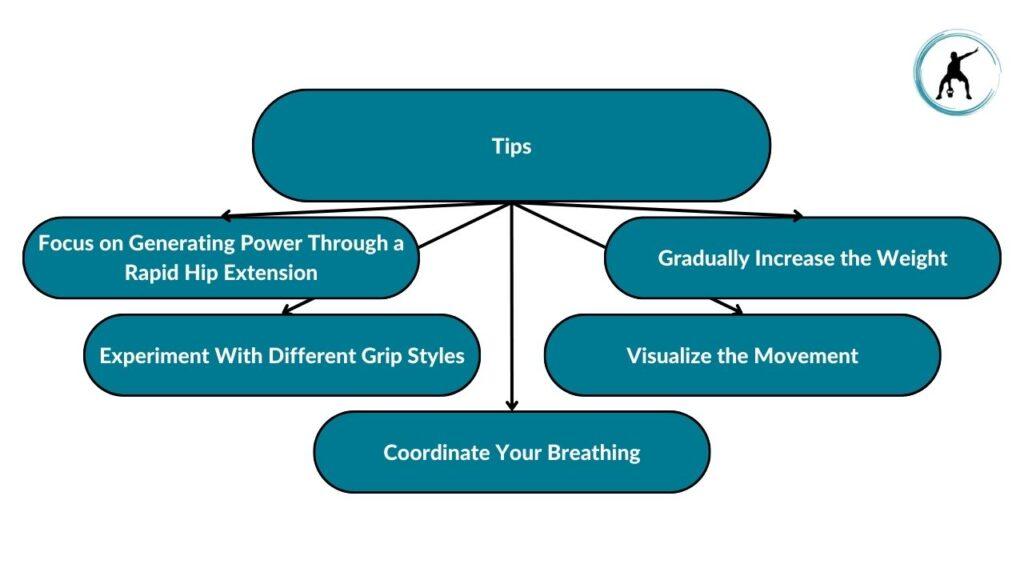
Focus on Generating Power Through a Rapid Hip Extension
To generate power from rapid hip extension, forcefully drive your hips forward and upward as you transition from the squat position to standing. This explosive hip extension transfers energy efficiently from the lower body to the upper body, allowing you to lift the medicine ball with speed and power.
Experiment With Different Grip Styles
Changing up your grip and trying different types can help you find the most comfortable and efficient grip for your body mechanics and goals. Try variations such as an overhand grip, underhand grip, or a mixed grip to determine which feels most natural and allows for the best control and power transfer throughout the movement.
Also, adjusting your grip width or hand placement on the ball can influence how you engage certain muscle groups and may optimize your performance.
Coordinate Your Breathing
Not breathing correctly can reduce the effectiveness of the exercise. Inhale deeply as you lower into the squat position to gather energy and brace your core. Then, exhale forcefully as you explosively extend your hips, knees, and ankles to lift the ball, helping to generate power and stabilize your core.
Finally, inhale again as you catch the ball in the front rack position, maintaining control and preparing for the next repetition. Consistent and rhythmic breathing throughout the movement enhances coordination and ensures optimal oxygen delivery to your muscles, improving performance and reducing fatigue.
Visualize the Movement
Picture and analyze what you need to do in your head before you start the exercise. It can really help you perform with the correct form.
For instance, if you can’t visualize one part of the exercise in your head, there is a high chance of you doing it in bad form because you don’t even know what you have to do. Try visualizing, and if one part is not clear to you, do a little research, maybe read instructions one more time, or watch a video.
Gradually Increase the Weight
Like every other exercise, you should progressively overload. Don’t jump from 15 pounds to 20. Increase a little bit each week and work regularly. Jumping from light to heavy can lead to injury, and if not injury, bad form.
Mistakes
Down below are some of the most common mistakes people make while performing medicine ball clean.
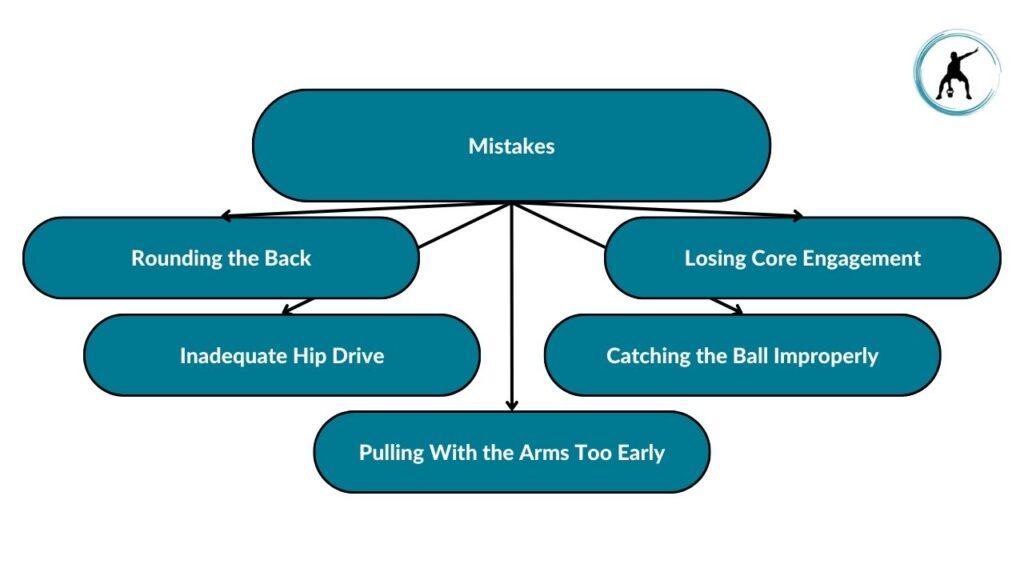
Rounding the Back
Rounding the back places excessive stress on the spine, which can lead to injury and reduce the exercise’s effectiveness. It also changes muscle engagement.
To avoid this mistake, focus on maintaining a straight back throughout the movement, keeping your chest up, shoulders back, and core engaged. This ensures proper alignment and distributes the load evenly across the muscles, promoting safer and more efficient execution of the medicine ball clean.
Inadequate Hip Drive
Insufficient hip drive during the medicine ball clean leads to a lack of explosive hip extension, which is essential for generating power and lifting the ball efficiently. This results in predominantly using upper body strength rather than the powerful muscles of the lower body to initiate the movement.
To correct this, focus on driving the hips forcefully forward and upward as you transition from the squat position to standing, maximizing the transfer of energy from the lower body to the upper body. Proper hip drive results in effectiveness and power output and reduces the risk of overloading the arms and shoulders.
Pulling With the Arms Too Early
Pulling with the arms before fully extending the lower body compromises the movement’s power and efficiency. This mistake often leads to relying too much on the arms and shoulders rather than utilizing the explosive power generated by the legs and hips.
To correct this error, focus on starting the movement with a rapid extension of the hips, knees, and ankles. This allows the momentum to transfer smoothly to the upper body before pulling the ball upward with the arms. By synchronizing the movement and delaying the arm pull until the lower body has fully engaged, you can maximize power output and perform the medicine ball clean more effectively.
Catching the Ball Improperly
Catching the ball improperly during the medicine ball clean occurs when the athlete fails to position themselves correctly to receive the ball after the lift. This mistake can lead to loss of control, dropped balls, and potential injury.
Proper catching technique involves pulling the elbows high, keeping the chest up, and squatting to absorb the impact of the ball, ensuring it lands securely in the front rack position.
To correct this error, focus on maintaining a stable and strong stance, actively pulling the elbows high to guide the ball into position, and using the legs to absorb the force of the catch. Practicing proper catching techniques will improve control and efficiency during the medicine ball clean exercise.
Losing Core Engagement
Losing core engagement often leads to poor posture, decreased power transfer, and increased risk of injury, as the core plays a crucial role in maintaining stability and transferring force between the lower and upper body.
To correct this error, focus on keeping the core muscles engaged by bracing the abdominals and maintaining a strong, neutral spine from start to finish. Avoid arching or rounding the back, and concentrate on maintaining proper alignment to optimize power generation and protect the spine.
Medicine Ball Clean Variations
Here are some of the variations you can use with or instead of medicine ball clean.
Medicine Ball Power Clean
While both exercises target similar muscle groups and involve lifting the medicine ball from the ground to a standing position, this variation emphasizes explosive power and speed. In contrast, the standard clean emphasizes squat depth and control.
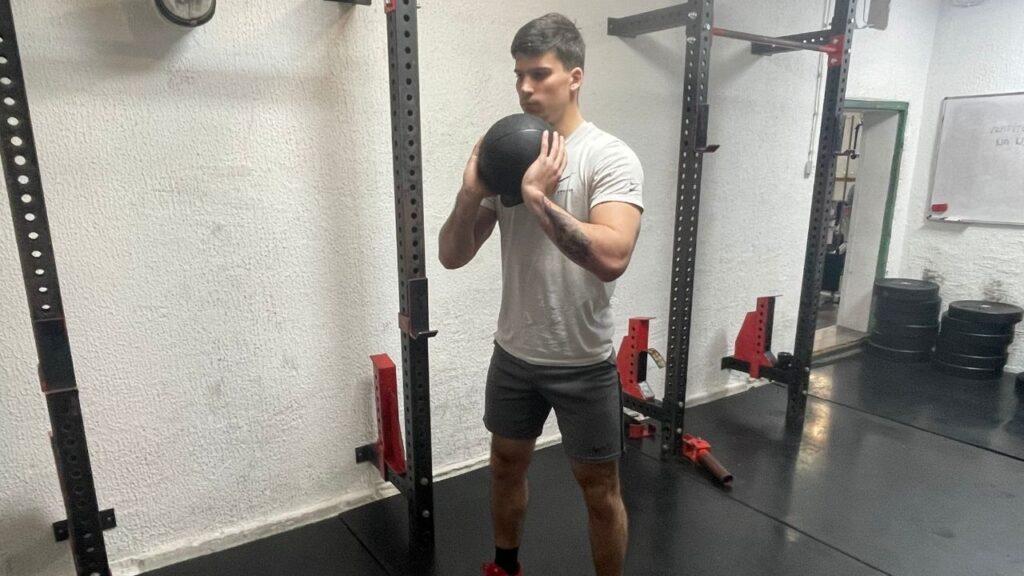
The main difference between normal med ball clean and power clean is the depth of the squat; here’s how to perform it:
- Start by standing with your feet hip-width apart and the medicine ball on the ground in front of you. Squat down halfway, keeping your back straight and chest up.
- Explosively extend your hips, knees, and ankles while pulling the medicine ball up towards your chest. As the ball reaches chest height, use the momentum to stand up, extending your arms fully overhead quickly.
- Catch the medicine ball in a standing position with your arms extended overhead. Bend your knees and hips slightly to absorb the impact, keeping your core engaged throughout the movement.
- Lower the medicine ball back down to the starting position by bending your knees and hips and squatting down halfway again.
Pro tip: Focus on the explosive extension of your hips, knees, and ankles to generate maximum power. This rapid extension, coupled with a strong pull of the medicine ball towards your chest, will help you lift the ball with speed and efficiency.
Medicine Ball Squat Clean
This variation of the exercise will focus a little more on the legs. A squat clean requires a deeper squat than a normal clean and catching the ball in a squat position.

Here’s how to perform it:
- Begin with your feet shoulder-width apart and the medicine ball on the ground in front of you. Squat down fully, keeping your back straight and chest up, and grab the medicine ball with both hands.
- Explosively extend your hips, knees, and ankles while pulling the medicine ball up towards your chest. As the ball reaches chest height, quickly drop into a full squat position, lowering your body to at least parallel or below parallel to the ground.
- Catch the medicine ball in the full squat position, with your elbows pointed forward and your hips back. Keep your chest up and core engaged to maintain stability.
- Stand up explosively, driving through your heels, and extend your hips and knees fully. Finish the movement standing tall with the medicine ball held at chest level.
Pro tip: Focus on quickly descending into a full squat to catch the ball, then stand up explosively to complete the movement.
Medicine Ball Clean to Press
This variation of the exercise adds one more step. After completing the clean portion of the movement, where the ball is lifted explosively to chest height, the athlete adds an overhead press or shoulder press motion to extend their arms and lift the ball overhead fully.
This additional pressing movement increases the challenge on the shoulders, arms, and core muscles, requiring more upper body strength and coordination compared to a standard clean.
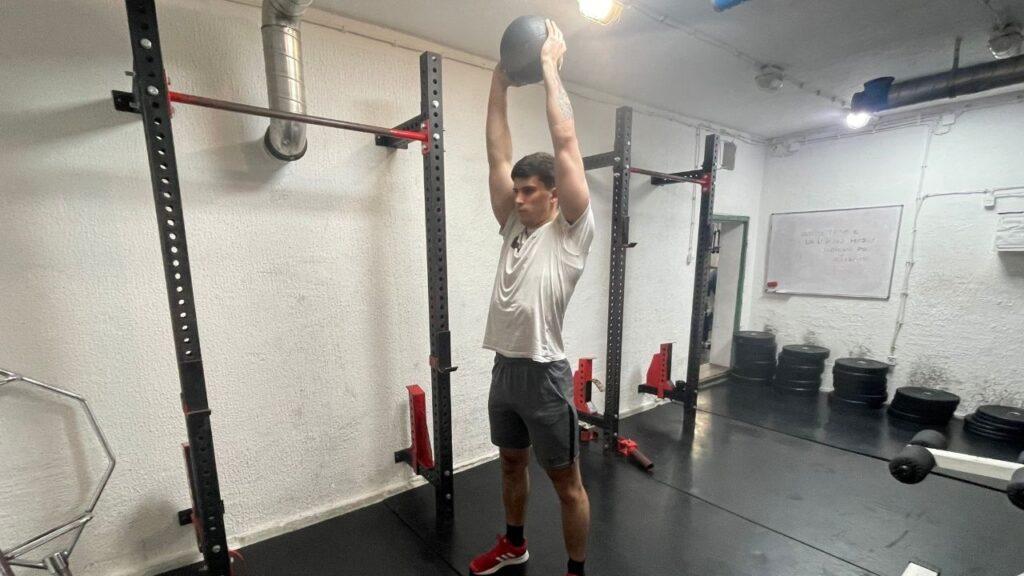
Here’s how to perform it:
- Start with your feet shoulder-width apart and the medicine ball on the ground in front of you. Squat down and grab the medicine ball with both hands, keeping your back straight and chest up.
- Explosively extend your hips, knees, and ankles while pulling the medicine ball up towards your chest. As the ball reaches chest height, catch it securely against your chest while transitioning your grip so that your palms are facing upwards.
- From the caught position, quickly extend your arms overhead in a pressing motion, fully extending your elbows and lifting the medicine ball overhead.
- Pause briefly at the top of the press, ensuring that your arms are fully extended and the medicine ball is directly overhead.
- Lower the medicine ball back down to the starting position by reversing the pressing motion, bringing the ball back to chest height, and then back down to the ground.
Pro tip: Engage your core muscles to stabilize your body during the press, and avoid arching your back excessively.
Medicine Ball Clean Alternatives
Here are a few alternative exercises you can use that might work better for you.
Kettlebell Swings
Kettlebell swings primarily target the posterior chain muscles, including the glutes, hamstrings, and lower back, which are crucial for athletic performance, functional movement, and injury prevention.
They are easier to perform, more beginner-friendly, and much easier to progress. In general, kettlebells are heavier and have more weight gaps than medicine balls. Kettlebells are also easier to find in the gym, so this is a very viable option.
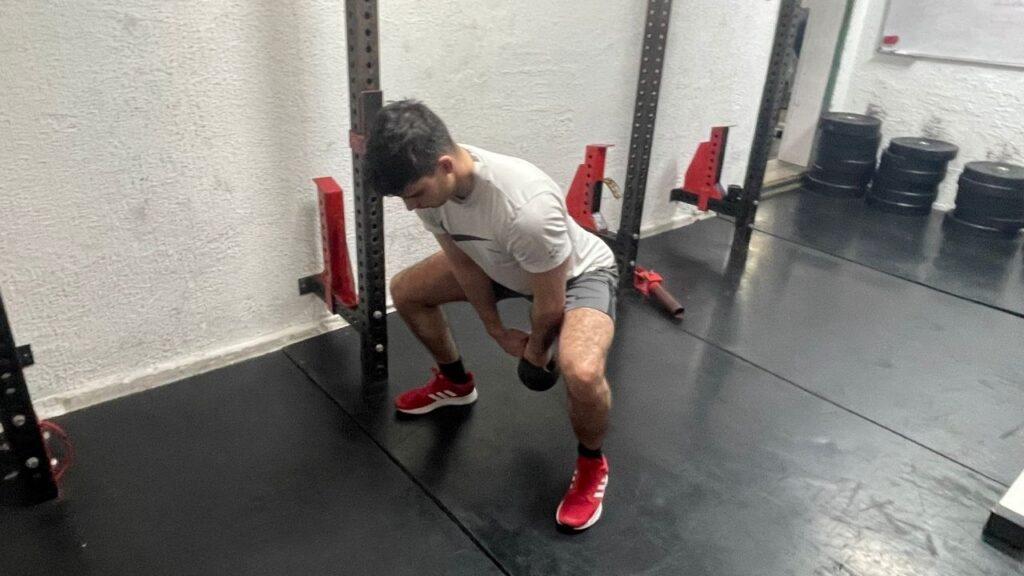
Here’s how to perform it:
- Stand with your feet shoulder-width apart, toes pointing slightly outwards. Hold the kettlebell with both hands in front of your body, arms extended.
- To begin the movement, swing the kettlebell back between your legs by bending your knees slightly while maintaining a straight back. Your arms should be relaxed, and the kettlebell should be behind your body at this point.
- Explosively extend your hips and thrust them forward, swinging the kettlebell out in front of you. Keep your arms straight and let the momentum from your hips propel the kettlebell forward.
- Allow the kettlebell to swing back down between your legs, bending your knees slightly as needed. Maintain a tight core and straight back throughout the movement. Repeat the swing motion for desired repetitions.
Pro tip: Engage your core muscles throughout the exercise and avoid using your arms to lift the kettlebell. Focus on generating power from your hips and maintaining proper form to maximize the effectiveness of the exercise.
Barbell Power Clean
Barbell power clean is another great alternative to medicine ball clean. While both offer benefits for strength, power, and athleticism, the barbell power clean is often preferred for its greater load capacity, specificity to weightlifting, and versatility in programming.
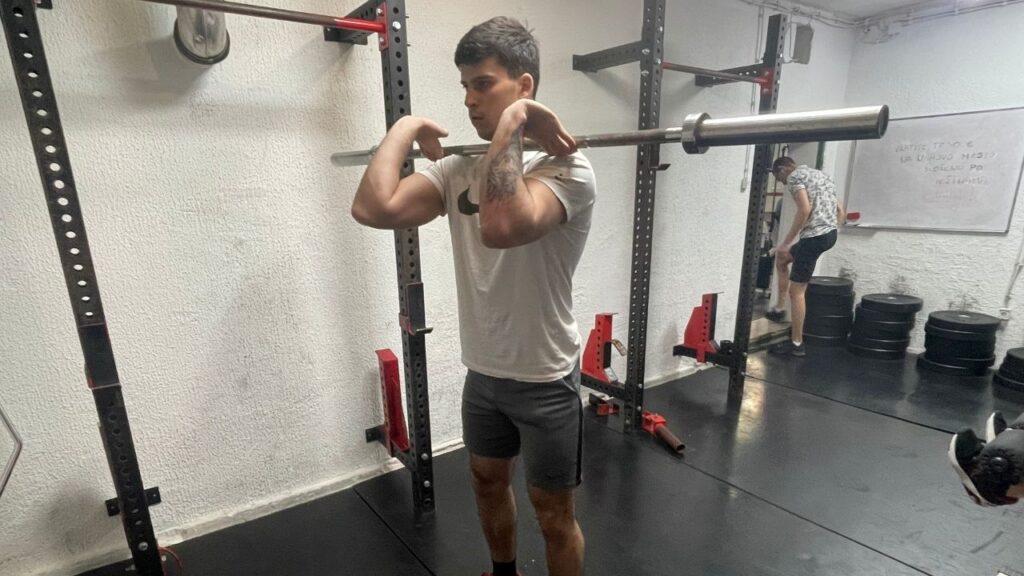
Here’s how to perform it:
- Grip the barbell with hands slightly wider than shoulder-width, back straight, and chest up.
- Drive through legs, extending hips and knees explosively to lift the barbell off the floor, keeping it close to your body.
- Extend hips and knees and shrug shoulders upward. Pull the barbell upward, then drop into a partial squat position, catching it across your shoulders.
- Rotate your elbows forward, catching the barbell in the rack position. Extend your hips and knees explosively to stand up.
Pro tip: Practice proper form with lighter weights before progressing to heavier loads. Ensure safety with collars and proper supervision, especially for beginners.
Sandbag or Kettlebell Cleans
Sandbag or kettlebell cleans offer unique benefits, including variable resistance, functional strength development, grip strength enhancement, and core stability improvement.
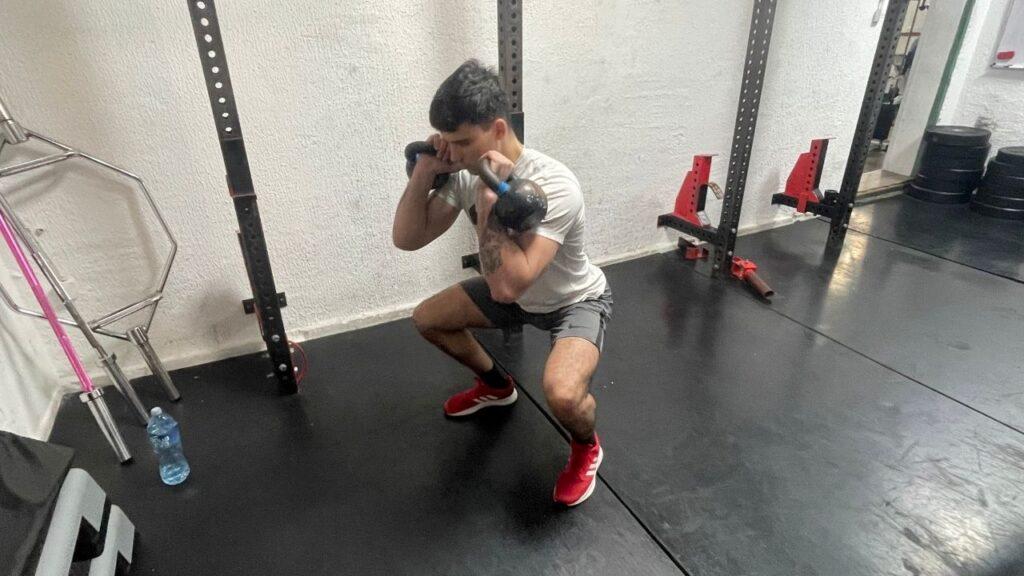
Here’s how to perform it:
- Stand with feet shoulder-width apart, squat down, and grab sandbag handles.
- Drive through legs explosively, lifting a sandbag with hips and pulling it upward.
- Flip your elbows under the sandbag and catch it across your shoulders in a racked position.
- Stand up explosively, extending hips and knees while maintaining a sandbag in a racked position.
Pro tip: Make sure to jump and catch the sandbag, not bring it to your shoulder. This is a very common mistake, and it’s easy to fix.
FAQs
How Effective Is a Medicine Ball?
Medicine ball training is very effective at boosting throwing and swinging performance.
What Are 3 Advantages of Medicine Balls?
Some of the advantages of medicine balls are functional movements, coordination and balance, and core strength.
What Are the Disadvantages of Medicine Ball Exercises?
The disadvantages of medicine balls can include common form mistakes that often switch targeting muscles, leading to injuries and a lack of maximum weight.
Which Is Better, Kettlebell or Medicine Ball?
Kettlebells and medicine balls are better in their fields. The medicine ball is excellent for building strength and endurance, making it ideal for rehabilitation. At the same time, the kettlebell can be used for numerous exercises, including lifts, swings, squats, and more, to increase core strength.
Do Medicine Balls Build Muscles?
Medicine balls do build muscle and can be used in strength training when performing certain exercises.
Wrapping Up
Medicine ball clean might not be the most popular exercise, but that doesn’t mean it’s not effective.
Using it for functional training, especially in sports, will enhance your performance. You won’t need hundreds of sets to get yourself tired, but you will feel the changes it provides.
Train consistently, and you will see the benefits very fast. Progressive overload and the right form will maximize its effectiveness. Treat it like any other exercise.
Start Building Your Dream Body Today
Ready to elevate your fitness game without falling into the trap of dull, repetitive routines that just don’t deliver? Imagine sculpting your ideal physique and boosting your health, all while still enjoying life’s pleasures, like those irresistible weekend getaways and your aunt’s legendary cheesecake. With our online fitness and nutrition coaching service, you don’t have to compromise. Dive into a personalized fitness journey that blends perfectly with your lifestyle, not against it. Book your completely free discovery consultation today, and take the first step towards a transformation that doesn’t require giving up the joys of life.

“I was skeptical about online fitness coaching, but Functional Body Savage completely changed my perspective. Vanja and Radomir’s personalized approach and attention to detail have helped me achieve goals I never thought possible. I’m stronger, more confident, and grateful for their guidance.”
Emily Thompson, San Francisco, CA
Learn More About Our Online Coaching ServiceReferences:
- Ignjatovic AM, Markovic ZM, Radovanovic DS. Effects of 12-week medicine ball training on muscle strength and power in young female handball players. J Strength Cond Res. 2012;26(8):2166-2173. doi:10.1519/JSC.0b013e31823c477e

